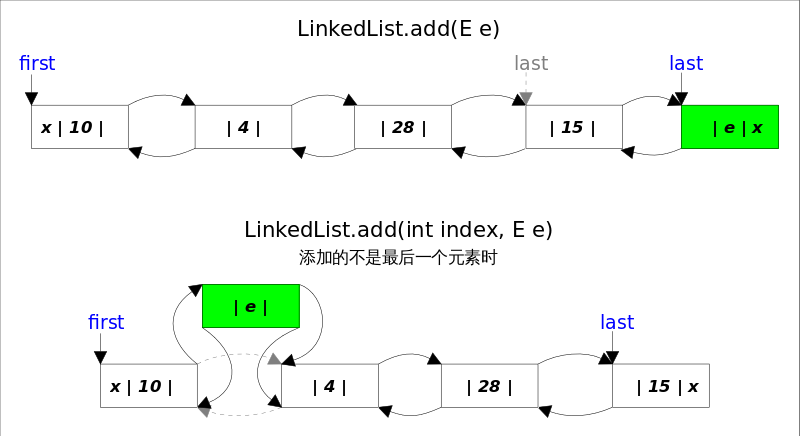CH03-LinkedList
概述
- LinkedList 同时实现了 List 接口和 Deque 接口,也就是说它既可以看作一个顺序容器,又可以看作一个队列(Queue),同时又可以看作一个栈(Stack)。
- 栈或队列,现在的首选是 ArrayDeque,它有着比 LinkedList (当作栈或队列使用时)有着更好的性能。
- 所有跟下标相关的操作都是线性时间。
- 在首段或者末尾删除元素只需要常数时间。
- 为追求效率 LinkedList 没有实现同步(synchronized)。

内部实现
数据结构
- 底层通过双向链表实现。
- 双向链表的每个节点用内部类 Node 表示。
- LinkedList 通过
first和last引用分别指向链表的第一个和最后一个元素。 - 当链表为空的时候
first和last都指向null。
transient int size = 0;
/**
* Pointer to first node.
* Invariant: (first == null && last == null) ||
* (first.prev == null && first.item != null)
*/
transient Node<E> first;
/**
* Pointer to last node.
* Invariant: (first == null && last == null) ||
* (last.next == null && last.item != null)
*/
transient Node<E> last;
private static class Node<E> {
E item;
Node<E> next;
Node<E> prev;
Node(Node<E> prev, E element, Node<E> next) {
this.item = element;
this.next = next;
this.prev = prev;
}
}
构造函数
/**
* Constructs an empty list.
*/
public LinkedList() {
}
/**
* Constructs a list containing the elements of the specified
* collection, in the order they are returned by the collection's
* iterator.
*
* @param c the collection whose elements are to be placed into this list
* @throws NullPointerException if the specified collection is null
*/
public LinkedList(Collection<? extends E> c) {
this();
addAll(c);
}
getFirst, getLast
/**
* Returns the first element in this list.
*
* @return the first element in this list
* @throws NoSuchElementException if this list is empty
*/
public E getFirst() {
final Node<E> f = first;
if (f == null)
throw new NoSuchElementException();
return f.item;
}
/**
* Returns the last element in this list.
*
* @return the last element in this list
* @throws NoSuchElementException if this list is empty
*/
public E getLast() {
final Node<E> l = last;
if (l == null)
throw new NoSuchElementException();
return l.item;
}
removeFirest(), removeLast(), remove(e), remove(index)
remove 可以删除首个 equals 指定对象的元素,或者删除指定位置的元素。

add
add(E e) 将在末尾添加元素,因为 last 指向链表的末尾元素,因此操作为常数时间,仅需修改几个相关的引用即可。
add(int index, E element) 是在指定位置插入元素,首选需要线性查找到具体位置,然后修改相关引用,完成操作。

addAll
addAll(index, c) 实现方式并不是直接调用add(index,e)来实现,主要是因为效率的问题,另一个是fail-fast中modCount只会增加1次;
/**
* Appends all of the elements in the specified collection to the end of
* this list, in the order that they are returned by the specified
* collection's iterator. The behavior of this operation is undefined if
* the specified collection is modified while the operation is in
* progress. (Note that this will occur if the specified collection is
* this list, and it's nonempty.)
*
* @param c collection containing elements to be added to this list
* @return {@code true} if this list changed as a result of the call
* @throws NullPointerException if the specified collection is null
*/
public boolean addAll(Collection<? extends E> c) {
return addAll(size, c);
}
/**
* Inserts all of the elements in the specified collection into this
* list, starting at the specified position. Shifts the element
* currently at that position (if any) and any subsequent elements to
* the right (increases their indices). The new elements will appear
* in the list in the order that they are returned by the
* specified collection's iterator.
*
* @param index index at which to insert the first element
* from the specified collection
* @param c collection containing elements to be added to this list
* @return {@code true} if this list changed as a result of the call
* @throws IndexOutOfBoundsException {@inheritDoc}
* @throws NullPointerException if the specified collection is null
*/
public boolean addAll(int index, Collection<? extends E> c) {
checkPositionIndex(index);
Object[] a = c.toArray();
int numNew = a.length;
if (numNew == 0)
return false;
Node<E> pred, succ;
if (index == size) {
succ = null;
pred = last;
} else {
succ = node(index);
pred = succ.prev;
}
for (Object o : a) {
@SuppressWarnings("unchecked") E e = (E) o;
Node<E> newNode = new Node<>(pred, e, null);
if (pred == null)
first = newNode;
else
pred.next = newNode;
pred = newNode;
}
if (succ == null) {
last = pred;
} else {
pred.next = succ;
succ.prev = pred;
}
size += numNew;
modCount++;
return true;
}
clear
为了让GC更快可以回收放置的元素,需要将node之间的引用关系赋值为 null。
/**
* Removes all of the elements from this list.
* The list will be empty after this call returns.
*/
public void clear() {
// Clearing all of the links between nodes is "unnecessary", but:
// - helps a generational GC if the discarded nodes inhabit
// more than one generation
// - is sure to free memory even if there is a reachable Iterator
for (Node<E> x = first; x != null; ) {
Node<E> next = x.next;
x.item = null;
x.next = null;
x.prev = null;
x = next;
}
first = last = null;
size = 0;
modCount++;
}
Positional Access 方法
通过 index 获取元素:
public E get(int index) {
checkElementIndex(index);
return node(index).item;
}
通过 index 赋值元素:
public E set(int index, E element) {
checkElementIndex(index);
Node<E> x = node(index);
E oldVal = x.item;
x.item = element;
return oldVal;
}
通过 index 插入元素:
public void add(int index, E element) {
checkPositionIndex(index);
if (index == size)
linkLast(element);
else
linkBefore(element, node(index));
}
通过 index 删除元素:
public E remove(int index) {
checkElementIndex(index);
return unlink(node(index));
}
查找
即查找元素的下标,查找第一次出现元素值相等的 index,否则返回 -1:
public int indexOf(Object o) {
int index = 0;
if (o == null) {
for (Node<E> x = first; x != null; x = x.next) {
if (x.item == null)
return index;
index++;
}
} else {
for (Node<E> x = first; x != null; x = x.next) {
if (o.equals(x.item))
return index;
index++;
}
}
return -1;
}
查找最后一次出现的元素则类似,区别是从 last 开始向前查找。
Queue 方法
- peek
- element
- poll
- remove
- offer
Deque 方法
- offerFirst
- offerLast
- peekFirst
- peekLast
- pollFirst
- pollLast
- push
- pop
Feedback
Was this page helpful?
Glad to hear it! Please tell us how we can improve.
Sorry to hear that. Please tell us how we can improve.